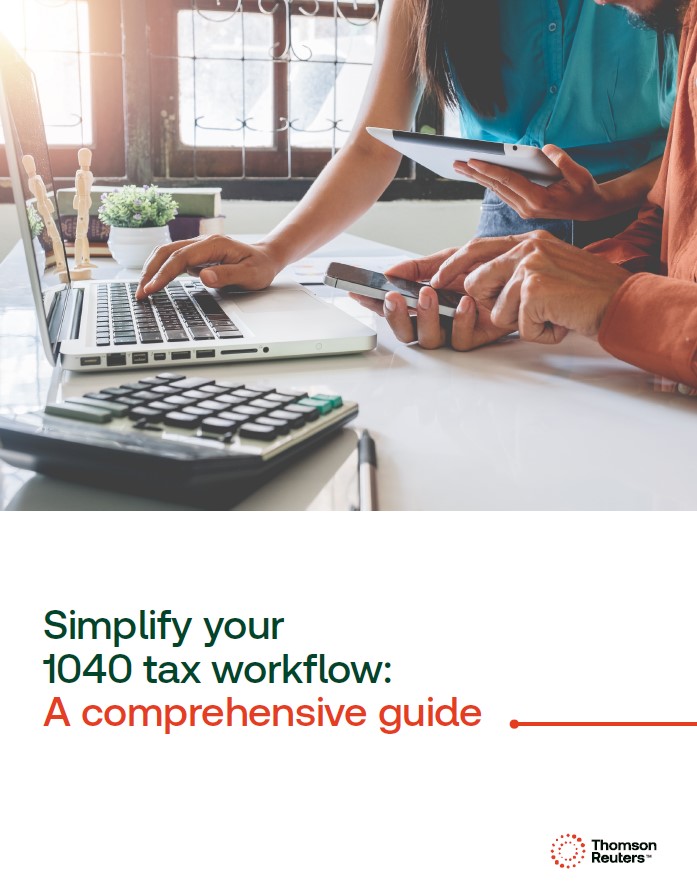Explore the benefits of a digital tax workflow, automation for tax workflows, differences between individual and business tax return workflows, and more.
If there is one thing accountants and tax preparers know for sure, it’s that an efficient tax workflow is key to remaining competitive in an increasingly digital tax and accounting landscape.
Defined as the systematic process of managing all tasks involved in the preparation, filing, and review of tax returns, today’s tax workflow encompasses AI-powered tools, processes, and procedures used by tax professionals to complete their work efficiently and accurately.
The goal is smooth coordination among clients and staff members, increased accuracy and productivity, and more time for value-added activities, like advisory services. To achieve this, many forward-looking accountants and tax preparers are shifting toward a fully digital tax workflow.
Let’s take a look at what a digital tax workflow is all about and how it can unlock efficiencies for your accounting firm.
Jump to ↓
| What is a digital tax workflow? |
| What is tax workflow automation? |
| Individual versus business tax returns: Differences in tax workflows |
| Tax workflow best practices |
| What is the best tax workflow software? |
What is a digital tax workflow?
First, the basics. A is the process of managing tax preparation, review, and filing entirely through online tools. It eliminates the need for paper-based processes and manual data entry, replacing them with cloud-based systems, automation, and electronic communication.
Specifically, the key components of a digital tax workflow include:
- Client data collection. Secure client portals are used to gather documents such as W-2s, 1099s, and financial statements digitally, allowing clients to upload tax documentation directly to tax preparers.
- Data input and integration. Tax software integrates with other financial systems, automatically pulling in relevant data like payroll or financial statements, reducing manual data entry and minimizing errors.
- Tax preparation. streamline the tax return calculation process, ensuring up-to-date compliance with tax laws through built-in guidance and error-checking.
- Review and collaboration. Accounting firm staff can review tax returns digitally, collaborate in real-time, and make necessary adjustments. Any updates are synced immediately, ensuring version control throughout the review process.
- Filing and storage. Digital workflows allow for the electronic filing of tax returns with the IRS or other authorities. All records are securely stored in the cloud, making them easily accessible for future reference.
A digital tax workflow is achieved by leveraging comprehensive tax preparation solutions like UltraTax CS that enable secure document storage, data integration, real-time collaboration, and automated checks for compliance and accuracy. With tools to handle a wide range of tax returns, including individual (personal), business, partnership, trust, estate, and nonprofit returns, UltraTax CS streamlines the entire tax preparation process through automation, data import features, and cloud-based access.
The benefits of making tax digital
As accountants and tax preparers know, traditional methods of document collection and data entry are extremely inefficient. With digital tools, accountants no longer have to juggle physical paperwork and manual data entry, thus minimizing the risk of human error and lost files.
With a digital tax workflow, all documentation is centralized, searchable, and securely stored, allowing multiple staff members to access and collaborate on tax returns in real-time. In addition, built-in error-checking features reduce the likelihood of mistakes and ensure compliance with the latest tax regulations.
This streamlined, paperless approach enhances accuracy, boosts efficiency, and allows tax professionals to work from anywhere, making it an ideal solution for accounting firms looking to stay ahead in a competitive landscape.
Remote tax workflow
As remote work becomes more prevalent, digital tax workflows enable tax professionals to collaborate effectively, regardless of their location. also mean faster turnarounds, as documents can be uploaded, reviewed, and shared without delay no matter where your staff members are located.
From a talent perspective, the ability to work remotely is a competitive advantage. Top-tier tax professionals no longer want manual data entry to be part of their job description as evidenced by high performing talent often migrating to firms that have digitized their workflow processes. Leveraging remote tools help ease the burden of tax season, reduce stress, and free up more time to focus on fulfilling work.
With a solution like UltraTax CS, you can empower your staff to access tax files from anywhere, opening the door to better collaboration between team members and clients. With automation, integration, and secure cloud-access, UltraTax CS is a trusted solution for tens of thousands of accounting firms looking to improve the efficiency and accuracy of their tax preparation workflow.
What is tax workflow automation?
involves leveraging technology to perform routine tasks, freeing up accountants to focus on more value-added activities, like advisory services. Automated workflows can handle data entry, document collection, client communications, and error-checking, ensuring a faster and more efficient process.
Key components of tax workflow automation include:
- Automated tax data collection and input. Tax workflow automation tools pull client data directly from integrated accounting or payroll systems, eliminating the need for manual entry. You can also enable clients to upload documents through secure portals, automatically organizing and categorizing them for your tax preparers.
- Document management. Digital document management systems enable tax preparers to organize, store, and retrieve client documents quickly. Automated workflows ensure that the correct files are assigned to the appropriate tax returns, and all necessary documents are accounted for before filing.
- Error checking and compliance. An automated tax workflow can identify discrepancies, missing information, or potential errors in tax returns in real-time. Built-in compliance checks ensure that the tax return adheres to the latest regulations, reducing the risk of filing errors.
- Task tracking and deadlines. Digital tax workflow automation tools track the progress of each tax return, automatically assigning tasks to staff members and setting deadlines. Notifications and reminders are sent to staff and clients to ensure important action items are completed on time.
- Client communication. Automated communication tools streamline the process of requesting documents, sending reminders, and following up with clients, ensuring that the tax workflow moves forward without unnecessary delays.
- E-filing and submission. The final stage of the tax process — filing returns electronically with tax authorities — can also be automated. Once a return is complete, the software automatically submits it and stores a digital copy for future access.
Tools that enable digital tax workflow automation
By leveraging digital tax workflow automation tools, accounting firms can reduce the manual work required for data entry, document management, client communication, and compliance checks, allowing tax professionals to focus on higher-value tasks, like advisory services.
Together with UltraTax CS, 1040SCAN is a comprehensive 1040 productivity solution designed to help accounting firms increase productivity and profitability with a totally digital tax workflow. By eliminating redundancy in data movement, the APIs in SurePrep provide a single interface that allows you to ingest data in real time without having to import and export data, ending the need to bounce back and forth between applications.
When it comes to organizing client documentation, SPBinder leverages AI to automate the collection and processing of digital documents directly from clients as well as automatically extract and populate data in tax compliance software. Automating these mundane tasks gives accountants more time to dedicate to strategic activities and enables your firm to handle more clients without significantly expanding your workforce.
Additionally, an AI-powered workflow can also automate more complex tasks such as analyzing data to support your firm in providing data-driven insights like forecasting financial trends and identifying areas of risk. By offering these new advisory-based services, your firm can transition from billable hours to a value-based pricing model that provides additional sources of revenue and deeper relationships with clients.
Benefits of an automated tax workflow
An automated tax workflow saves time by reducing manual data entry and minimizing errors. Automated tools can pull client data directly from integrated systems, eliminating the need for redundant inputs. Notifications and reminders can also be automated, keeping both clients and staff on track with deadlines. In addition, automated workflows offer a higher degree of accuracy, as systems flag discrepancies and omissions before they become costly mistakes.
Benefits for accounting firms:
- Improved productivity by eliminating tedious tasks
- Reduced staff turnover and burnout by prioritizing time for more fulfilling work
- Increased revenue given additional time to focus on strategic initiatives
- Elimination of human error resulting in more accurate audits and tax return preparation
Benefits for accounting staff:
- Elimination of monotonous data entry tasks
- Flexible, remote work opportunities
- Deeper relationships with clients and more engaging work
- Growth through professional development capabilities
Individual versus business tax returns: Differences in tax workflows
While the fundamental steps in a tax workflow are similar, the process differs when preparing individual (or personal) versus business tax returns.
Personal tax workflow
The 1040 workflow for individual tax returns typically involves gathering a broad range of documents from a single taxpayer, such as W-2s, 1099s, and investment information. The personal 1040 workflow process is generally more straightforward that a business tax return, though it still requires careful attention to detail. Digital tax workflow solutions allow individuals to upload documents securely, speeding up data entry and ensuring a smooth filing process.
Business tax workflow
Business tax returns, on the other hand, require a more complex workflow. Multiple financial statements, payroll information, and various forms of tax credits and deductions need to be accounted for. Business tax preparation often involves coordinating with multiple stakeholders and reviewing different types of data. Digital solutions can simplify this complexity by integrating financial and payroll systems, automating data entry, and providing a comprehensive audit trail.
Tax workflow best practices
By adopting a digital tax workflow and harnessing tax workflow automation, your accounting firm can optimize efficiency, boost productivity, and increase revenue.
To get the most out of your tax workflow, here are some best practices to consider:
Centralize document management
Use a secure, cloud-based document management system to store and organize client files in one central location and utilize client portals so clients can upload their tax documents directly. This keeps everything organized from the start and reduces time spent searching for information because all team members have real-time access to the most up-to-date documents.
UltraTax CS includes a customizable Client Organizer that accountants can use to gather tax-related information from clients. The organizer can be automatically generated and sent to clients, either in paper format or digitally via the portal. Clients can complete the organizer at their convenience, and once submitted, the information flows directly into UltraTax CS, reducing manual data entry.
Automate data entry and integration
Leverage AI-powered tax preparation software that integrates with other accounting and financial systems to automatically pull client data, reducing manual entry and minimizing errors.
With an advanced scan and populate solution like 1040SCAN, artificial intelligence (AI) and machine learning work together to bookmark and organize source documents into a standardized work paper index that follows the flow of the tax return. Through integration with UltraTax CS, GoSystem Tax RS, CCH Axcess Tax, and Lacerte, your firm can streamline data entry, simplify the filing of advanced returns, and maximize collaboration capabilities.
UltraTax CS can import data directly from accounting systems, payroll software, and prior year returns thus eliminating human error and giving your staff back valuable time for higher value work.
Implement automated checklists and task tracking
Create standardized workflows with automated checklists and task assignments for each tax return. This ensures that all required steps, such as document collection, review, and client approval, are completed in a timely manner.
With UltraTax CS, automated reminders can be configured to follow up with clients who haven’t yet submitted necessary information, keeping the workflow moving efficiently.
Use real-time collaboration tools
Encourage staff collaboration by using cloud-based software like UltraTax CS that allows multiple people to work on the same tax return simultaneously. This helps speed up reviews and reduces the chances of bottlenecks.
Perform regular quality reviews
Set up regular checkpoints for quality control throughout the tax preparation process. This can include automated error checks within the software and manual reviews by senior team members before final submission. Built-in error-checking features help identify discrepancies early, preventing costly mistakes and ensuring compliance.
Simplify client collaboration
Nobody like waiting on unresponsive clients for documents and signatures. But what confusing, counterintuitive collaboration tools are a catalyst for your poor communication?
SafeSend condenses the entire client experience into one user-friendly interface. Clients can upload documents, e-sign, fill out questionnaires, pay their invoice, review their return, and more all within a single portal. Giving clients an easy, centralized channel to collaborate can result in faster responses and higher satisfaction.
Monitor and update workflow regularly
Continuously review and update your tax workflow to incorporate new tools, tax law changes, and client feedback. This helps your team stay up to date with the latest technology and best practices. Regular updates ensure compliance with new tax regulations and help identify bottlenecks or inefficiencies in your existing workflow.
Train and develop your staff
Provide regular training and professional development opportunities for your team on the latest software updates, tax law changes, and workflow best practices. Continuous learning ensures that everyone is equipped to handle new challenges and that the workflow remains efficient.
Adopt a client-centric approach
Tailor your workflow to meet the unique needs of your clients. This could involve creating personalized checklists, offering flexible deadlines, or adapting to specific client requests. Focus on providing a smooth, seamless experience for clients to enhance retention and differentiate your firm from competitors.
By implementing these best practices, your firm can create a more efficient, automated, and accurate tax workflow, ultimately improving service quality and maximizing profitability.
What is the best tax workflow software?
Tens of thousands of U.S. accounting firms rely on UltraTax CS, the award-winning tax preparation software from Thomson Reuters, to streamline their workflow and boost productivity in an evolving business landscape.
With robust features for both individual and business tax preparation, UltraTax CS offers full integration with accounting software, automated data imports, and cloud-based access, making it a trusted choice for firms looking to enhance their digital tax workflows.
At the end of the day, a well-structured tax workflow is essential for delivering efficient, accurate, and timely tax preparation services. By adopting a fully digital and automated tax workflow, firms can not only streamline their processes but also reduce errors, improve collaboration, and meet client demands more effectively.
Whether handling personal or business tax returns, investing in digital tax workflow solutions like UltraTax CS can position your firm for greater success in an increasingly digital world.

Interactive e-book
Transform your tax and accounting firm’s workflow and client experience
Check it out ↗






